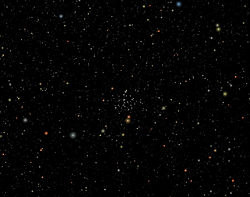NGC 1647

|
|
| NGC 1647 | |
| AladinLite | |
| Constellation | bull |
|
Position equinox : J2000.0 |
|
|---|---|
| Right ascension | 04 h 45 m 55.6 s |
| declination | + 19 ° 05 ′ 42 ″ |
| Appearance
|
|
| Brightness (visual) | 6.4 mag |
| Angular expansion | 40.0 ' |
| Physical data
|
|
| Affiliation | Milky Way |
| distance | 1750 ly (540 pc ) |
| history | |
| Discovered by | Wilhelm Herschel |
| Discovery time | February 15, 1784 |
| Catalog names | |
| NGC 1647 • C 0443 + 189 • OCl 457 • Mel 26 • Cr 54 • GC 896 • H VIII 8 • | |
NGC 1647 is an open star cluster in the constellation Taurus with a diameter of 40.0 'and a magnitude of 6.4 mag. It is located 4 ° northeast of the bright star Aldebaran not far from the open star cluster of the Pleiades . The star cluster is about 1,750 light years from Earth and has an actual diameter of 23 light years. It is estimated to be 150 million years old. Compared to the Pleiades, it also appears fainter because its brightness is weakened by one magnitude due to interstellar extinction, in addition to the significantly greater distance from the earth .
In NGC 1647 there is an eclipsing double star made up of two red dwarf stars of the spectral type M, whose mutual overlap allows an exact determination of their radii and masses. In addition to the known distance of the star cluster, the not yet fully understood development of stars with less than half the solar mass can be explored.
The object was discovered on February 15, 1784 by William Herschel .